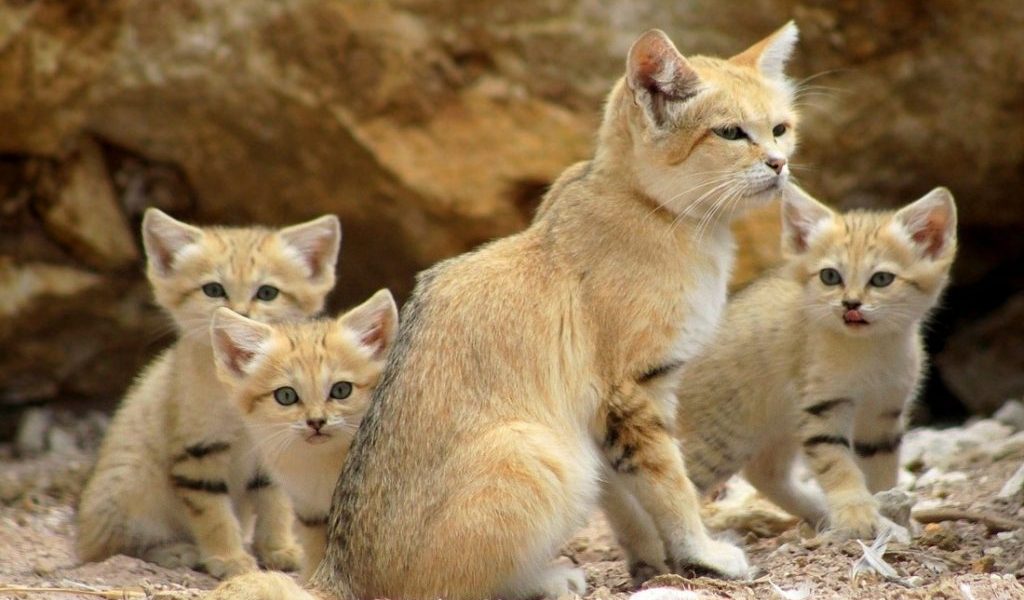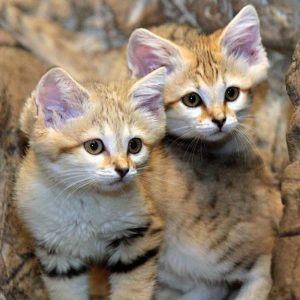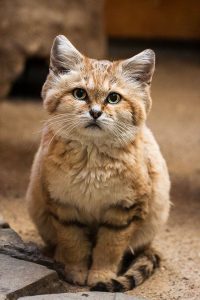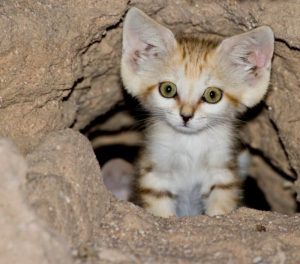
Sand Cat
imad - January 15, 2021Physical Description
Sand cats have a pale sandy to grey-brown coat, which is slightly darker on the back and pale on the belly, with occasional stripes on the legs. Bold, red streaks runs across each cheek from the corner of both eyes. Sand cats have a broad head with large eyes and low-set ears. They have short limbs.
Size
The tail, which can account for about half of the head-body length, features two or three rings and a black tip. Body length ranges from 18 to 22.5 inches (45 to 57 centimeters), with the tail adding on an extra 11 to 14 inches (28 to 35 centimeters). Adult sand cats weigh between 3 to 7.5 pounds (1 to 3.5 kilograms).
Native Habitat
Sand cats live in three distinct regions of the world: Africa’s Sahara desert, which stretches through Algeria, Niger and Morocco; throughout the Arabian peninsula; and in parts of central Asia including Turkmenistan, Iran, Pakistan and Afghanistan.
Sand cats prefer a very dry, arid habitat with little vegetation, for which they are well adapted. They are sand-dwelling creatures, inhabiting dry plains and rocky valleys where conditions are extreme. Surface temperatures can reach 124 degrees Fahrenheit (51 degrees C) during the daytime, then drop to as low as 31 degrees Fahrenheit (-0.5 degrees C) at night. This species prefers flat or rolling terrains, and will retreat to burrows when temperatures become too extreme. Due to the importance of burrowing and digging to sand cats, they are not found in areas where soil is compacted.
Food/Eating Habits
Sand cats eat primarily small rodents, occasionally hares, birds, spiders, insects and reptiles. They are fearless snake hunters—their prey can include venomous vipers and other snakes. Living in a relatively desolate habitat, sand cats are opportunistic feeders out of necessity. Like many desert-dwelling species, sand cats can survive without drinking water for weeks at a time. They will instead obtain any moisture they need from their prey.
Sand cats hunt by skulking close to the ground and using their enhanced sense of hearing to detect prey. Sounds of a potential meal burrowing underneath the ground trigger sand cats to begin digging rapidly to expose and capture prey. Upon capture, they may cover its kill and return later to feed.
At the Smithsonian’s National Zoo, they eat mice, bones and rib bone meat.
Social Structure
Sand cats have been known to take turns sharing shallow burrows, but will not occupy the burrow at the same time.
Reproduction and Development
Reproduction among sand cats depends on where they live; individuals from the Sahara will begin breeding in January and end in April. Those occurring in Turkmenistan will begin breeding in April, and in Pakistan the season will last from September to October. In human care, this species can breed more than once a year. The range in time of year chosen for breeding is believed to be a result of either climate or available resources.
Gestation for sand cats lasts 59 to 67 days, and females give birth to a litter of one to eight kittens, although two to four is most common. Kittens weigh just over 1 ounce (39 grams) at birth. Juveniles become independent by 6 to 8 months old, and will be sexually mature by 14 months.
Sleep Habits
Sand cats are mainly nocturnal and crepuscular animals, avoiding the intense heat of the desert by hiding in burrows. They rely on their ability to dig to create shelter from extreme weather.
Lifespan
In human care, sand cats can live to be 13 years old. Lifespan in the wild is unknown.
https://nationalzoo.si.edu/animals/sand-cat
Archives
Calendar
| M | T | W | T | F | S | S |
|---|---|---|---|---|---|---|
| 1 | 2 | 3 | 4 | 5 | ||
| 6 | 7 | 8 | 9 | 10 | 11 | 12 |
| 13 | 14 | 15 | 16 | 17 | 18 | 19 |
| 20 | 21 | 22 | 23 | 24 | 25 | 26 |
| 27 | 28 | 29 | 30 | 31 | ||



Leave a Reply
You must be logged in to post a comment.